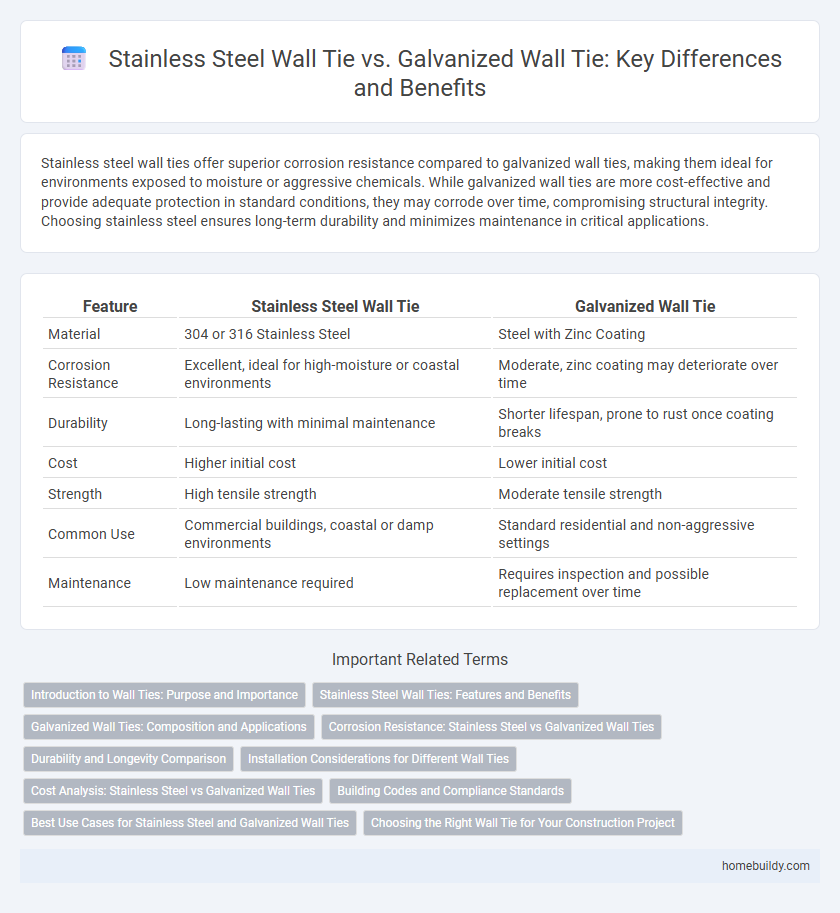Stainless steel wall ties offer superior corrosion resistance compared to galvanized wall ties, making them ideal for environments exposed to moisture or aggressive chemicals. While galvanized wall ties are more cost-effective and provide adequate protection in standard conditions, they may corrode over time, compromising structural integrity. Choosing stainless steel ensures long-term durability and minimizes maintenance in critical applications.
Table of Comparison
| Feature | Stainless Steel Wall Tie | Galvanized Wall Tie |
|---|---|---|
| Material | 304 or 316 Stainless Steel | Steel with Zinc Coating |
| Corrosion Resistance | Excellent, ideal for high-moisture or coastal environments | Moderate, zinc coating may deteriorate over time |
| Durability | Long-lasting with minimal maintenance | Shorter lifespan, prone to rust once coating breaks |
| Cost | Higher initial cost | Lower initial cost |
| Strength | High tensile strength | Moderate tensile strength |
| Common Use | Commercial buildings, coastal or damp environments | Standard residential and non-aggressive settings |
| Maintenance | Low maintenance required | Requires inspection and possible replacement over time |
Introduction to Wall Ties: Purpose and Importance
Wall ties are critical components in masonry construction designed to connect the outer brick or block wall to the inner structural frame, ensuring stability and load distribution. Stainless steel wall ties offer superior corrosion resistance, especially in environments exposed to moisture or saline conditions, enhancing durability and reducing maintenance costs. Galvanized wall ties provide a cost-effective solution with zinc coating protection but may be less effective in highly corrosive settings, making material selection crucial for long-term performance.
Stainless Steel Wall Ties: Features and Benefits
Stainless steel wall ties offer superior corrosion resistance compared to galvanized wall ties, making them ideal for environments exposed to moisture and harsh weather conditions. Their high tensile strength ensures long-lasting structural integrity and reduced maintenance costs over time. Stainless steel wall ties also provide excellent durability, preventing rust and degradation that can compromise the stability of masonry walls.
Galvanized Wall Ties: Composition and Applications
Galvanized wall ties are composed of low-carbon steel coated with a layer of zinc, providing corrosion resistance and durability in masonry construction. These wall ties are widely used in traditional brick and block walls where cost-effectiveness and moderate environmental exposure are key considerations. Their applications include securing cavity walls, preventing structural movement, and maintaining wall integrity under varying moisture conditions.
Corrosion Resistance: Stainless Steel vs Galvanized Wall Ties
Stainless steel wall ties offer superior corrosion resistance compared to galvanized wall ties due to their chromium-rich alloy composition, which forms a passive oxide layer protecting against rust and deterioration. Galvanized wall ties rely on a zinc coating that provides effective but limited protection, vulnerable to damage and eventual corrosion when exposed to harsh or prolonged moisture conditions. Choosing stainless steel ties ensures longer-lasting structural integrity in environments with high humidity or salt exposure, significantly reducing maintenance and replacement frequency.
Durability and Longevity Comparison
Stainless steel wall ties offer superior corrosion resistance compared to galvanized wall ties, making them ideal for environments prone to moisture or chemical exposure. Their high chromium content forms a passive layer that prevents rust, extending the lifespan significantly beyond that of galvanized options, which can deteriorate once the protective zinc coating is compromised. Consequently, stainless steel wall ties provide enhanced durability and longevity, reducing maintenance costs and structural risks over time.
Installation Considerations for Different Wall Ties
Stainless steel wall ties require careful handling during installation to prevent scratches that compromise corrosion resistance, making specialized tools and protective gloves essential on site. Galvanized wall ties offer easier installation with standard tools but demand thorough inspection for any coating damage to avoid premature rusting. Proper spacing and alignment remain critical for both types to ensure structural stability and long-term performance in masonry walls.
Cost Analysis: Stainless Steel vs Galvanized Wall Ties
Stainless steel wall ties typically cost 3 to 5 times more than galvanized wall ties due to their superior corrosion resistance and longevity, making them a more durable investment for high-moisture or coastal environments. Galvanized wall ties offer a lower upfront material cost and adequate protection in less aggressive conditions, but may require earlier replacement or maintenance, increasing long-term expenses. Evaluating project lifespan and environmental exposure is essential to determine the most cost-effective option between stainless steel and galvanized wall ties.
Building Codes and Compliance Standards
Stainless steel wall ties offer superior corrosion resistance compared to galvanized wall ties, making them essential for compliance with strict building codes in high-moisture or coastal environments. Building codes such as the International Building Code (IBC) and ASTM standards often specify stainless steel ties for projects requiring enhanced durability and long-term structural integrity. Using stainless steel wall ties ensures adherence to compliance standards related to material performance, preventing premature failure and costly repairs.
Best Use Cases for Stainless Steel and Galvanized Wall Ties
Stainless steel wall ties offer superior corrosion resistance, making them ideal for coastal or high-humidity environments where durability and long-term strength are critical. Galvanized wall ties provide cost-effective protection against rust and are best suited for interior or low-moisture applications where exposure to corrosive elements is minimal. Choosing stainless steel wall ties ensures enhanced structural integrity in aggressive climates, while galvanized ties effectively balance performance and budget for standard construction projects.
Choosing the Right Wall Tie for Your Construction Project
Stainless steel wall ties offer superior corrosion resistance, making them ideal for environments exposed to moisture or chemical agents, ensuring long-term structural integrity. Galvanized wall ties are cost-effective and provide adequate protection in less aggressive environments, suitable for standard residential or commercial projects where exposure is limited. Selecting the right wall tie depends on the project's durability requirements, environmental conditions, and budget constraints to optimize performance and lifespan.
Stainless steel wall tie vs Galvanized wall tie Infographic

 homebuildy.com
homebuildy.com